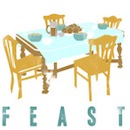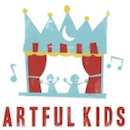I’ve been possessed by the archiving bug for most of my life. I’m terrible at throwing away anything that represents a piece of personal or family history. Mementos from my children and grandchildren, old negatives from the days before digital photos, desk calendars with a year of life scheduled in the pages, cards and letters — basically anything that has significance for me or my family story must be kept. That inclination, along with the urge to write, led me to the pages of diaries and journals.
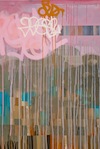 I do a fair amount of dreaming in terms of what sounds fun to do next. Who would be fun to work with? I have the luxury of being able to ask myself questions like that, and I take it pretty seriously. Josh, Sandra, and I were sitting around a few different times saying, “So what next? What am I gonna do? What follows the year I’ve just had?” And I looked at Josh with a smirk and said, “Time to make a worship record.”
I do a fair amount of dreaming in terms of what sounds fun to do next. Who would be fun to work with? I have the luxury of being able to ask myself questions like that, and I take it pretty seriously. Josh, Sandra, and I were sitting around a few different times saying, “So what next? What am I gonna do? What follows the year I’ve just had?” And I looked at Josh with a smirk and said, “Time to make a worship record.”  In the hands of another author, the blood and shame meted out in her stories would be cruel and nihilistic, a demonstration of an unfeeling universe smiting everyone alike. But O’Connor’s aim was different. She was focused at her core upon the Gospel, the arc of sin, redemption, and glorification, and though many of her stories stop short of redemption (much less glorification), redemption is the long shadow cast over the whole proceeding.
In the hands of another author, the blood and shame meted out in her stories would be cruel and nihilistic, a demonstration of an unfeeling universe smiting everyone alike. But O’Connor’s aim was different. She was focused at her core upon the Gospel, the arc of sin, redemption, and glorification, and though many of her stories stop short of redemption (much less glorification), redemption is the long shadow cast over the whole proceeding.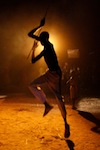 Celestin asked if I would help raise awareness. As a photographer/filmmaker, I set out to do just that. It’s difficult to get Americans to think twice about anything unless we are given provocative images. I started off by capturing stills and footage. That gained momentum until I had to start turning down my professional photography jobs and put all my time into making the movie. Clearly, raising awareness is just the beginning.
Celestin asked if I would help raise awareness. As a photographer/filmmaker, I set out to do just that. It’s difficult to get Americans to think twice about anything unless we are given provocative images. I started off by capturing stills and footage. That gained momentum until I had to start turning down my professional photography jobs and put all my time into making the movie. Clearly, raising awareness is just the beginning.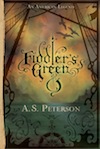 Storytelling is all about change. If characters don't change, you don't have a story, and change is achieved through the interaction of conflict and grace. Because Fin is such a strong-willed character, the forces necessary to affect her change needed to be even stronger. So there's a lot of pain in these two books, and a lot of resistance. But just like in life, the most painful times, and the times when we put up our strongest defenses, are the ones that eventually flower into the most beautiful seasons of renewal.
Storytelling is all about change. If characters don't change, you don't have a story, and change is achieved through the interaction of conflict and grace. Because Fin is such a strong-willed character, the forces necessary to affect her change needed to be even stronger. So there's a lot of pain in these two books, and a lot of resistance. But just like in life, the most painful times, and the times when we put up our strongest defenses, are the ones that eventually flower into the most beautiful seasons of renewal. As I took my seat in the hushed house, low lights came up on a minimal but rich wall of loosely joined wooden slats that allowed amber rays to seep through jagged cracks. A circle of Roman numerals implied a grand clock in the center of the expanse. As strains of Mozart’s “Requiem in D” began, gentle fog crept in and enveloped us. We passed the next two hours in the company of some of Nashville’s finest acting talents, all dressed in handsome, jeweled hues.
As I took my seat in the hushed house, low lights came up on a minimal but rich wall of loosely joined wooden slats that allowed amber rays to seep through jagged cracks. A circle of Roman numerals implied a grand clock in the center of the expanse. As strains of Mozart’s “Requiem in D” began, gentle fog crept in and enveloped us. We passed the next two hours in the company of some of Nashville’s finest acting talents, all dressed in handsome, jeweled hues. The distraction helps me forget the silver eyebrow, wayward twin of Normal. But I return to my departing gate and the young man remains where I left him. I cannot shake his innocuous but jarring irregularity, a feature allowing his face to hold the paradox of innocence and experience together in tension. Somehow he stands between the woman with the cane for whom the airport is a veritable gauntlet, and the young couple who could circumnavigate it all day and get up tomorrow to do it again. He wears on the outside what we get to hide from, put off, or ignore: our own slow march toward greater imperfection, and then, the end. It’s not about age; it’s about control.
The distraction helps me forget the silver eyebrow, wayward twin of Normal. But I return to my departing gate and the young man remains where I left him. I cannot shake his innocuous but jarring irregularity, a feature allowing his face to hold the paradox of innocence and experience together in tension. Somehow he stands between the woman with the cane for whom the airport is a veritable gauntlet, and the young couple who could circumnavigate it all day and get up tomorrow to do it again. He wears on the outside what we get to hide from, put off, or ignore: our own slow march toward greater imperfection, and then, the end. It’s not about age; it’s about control. To be sure, we don’t strive for proximate justice. Who wants to strive for an incomplete or imperfect Kingdom? By its very definition shalom means all things as they should be, in right relationship. But we do need an understanding of proximate justice to help us wait until then, even as we strive daily toward shalom in all corners of creation.
To be sure, we don’t strive for proximate justice. Who wants to strive for an incomplete or imperfect Kingdom? By its very definition shalom means all things as they should be, in right relationship. But we do need an understanding of proximate justice to help us wait until then, even as we strive daily toward shalom in all corners of creation.On Learning to Hear
Learning to hear has been a lifelong process for me, and the better I think I get, the more I know I miss. Part of it is like sorting one’s way through a blanket of static, desperately trying to pick out words of life in a cacophony of noise that seems designed to inflame rather than inform, to distract instead of clarify. But most of my problem is hubris, a deep-seated confidence that in something so ordinary and easy as hearing I have little to learn.
 I remember the first time someone actually purchased one of my CDs. It was 1999 at a roller-skating rink in Sacramento, California, where I was opening for a ska band (a story unto itself). The kid who made the purchase had blue hair and was probably sixteen. He handed me sweaty cash from his pocket saying, “I didn’t think I’d like you,” which I took as a compliment. Further, I took it as a sign that I’d made a connection and, as corny as it may sound, I was actually moved.
I remember the first time someone actually purchased one of my CDs. It was 1999 at a roller-skating rink in Sacramento, California, where I was opening for a ska band (a story unto itself). The kid who made the purchase had blue hair and was probably sixteen. He handed me sweaty cash from his pocket saying, “I didn’t think I’d like you,” which I took as a compliment. Further, I took it as a sign that I’d made a connection and, as corny as it may sound, I was actually moved. My husband, daughter, and I were in upstate New York for an extended vacation to see family, and I shot through the roll in three days. After each photograph I pulled the camera away from me to see what it looked like, a habit I’ve acquired with my DSLR, only to be reminded that this type of photography was not immediate. I had to wait. I had to take my time, adjust the camera and the focus carefully, and wait until the entire roll was exposed to take it to be developed.
My husband, daughter, and I were in upstate New York for an extended vacation to see family, and I shot through the roll in three days. After each photograph I pulled the camera away from me to see what it looked like, a habit I’ve acquired with my DSLR, only to be reminded that this type of photography was not immediate. I had to wait. I had to take my time, adjust the camera and the focus carefully, and wait until the entire roll was exposed to take it to be developed. Mumford & Sons bring to life what America seems to long for when we give ourselves over to the nostalgia of the Depression Era. Their poetry and poise bespeak a life of hardship and loss and yet, they haven't lost the hope of redemption — the beauty of suffering, even. There’s a refreshing absence of cynicism in their lyrics that provides a contrast to the dominant American attitude of entitlement, arrogance, and individualism which is often hard to shake off.
Mumford & Sons bring to life what America seems to long for when we give ourselves over to the nostalgia of the Depression Era. Their poetry and poise bespeak a life of hardship and loss and yet, they haven't lost the hope of redemption — the beauty of suffering, even. There’s a refreshing absence of cynicism in their lyrics that provides a contrast to the dominant American attitude of entitlement, arrogance, and individualism which is often hard to shake off. As I move farther and farther away from the way I believed as a child, is there anything left to hold onto? Is it possible to believe in anything so strongly again? In the song, Rob describes his grandfather’s faith and recounts a story his grandfather told him about “a train wreck in the ’60’s,” which brings up what theologians call theodicy, the problem of the existence of evil if there is a God.
As I move farther and farther away from the way I believed as a child, is there anything left to hold onto? Is it possible to believe in anything so strongly again? In the song, Rob describes his grandfather’s faith and recounts a story his grandfather told him about “a train wreck in the ’60’s,” which brings up what theologians call theodicy, the problem of the existence of evil if there is a God. So you dressed in linen on the threshing floor
So you dressed in linen on the threshing floorand made that man’s feet an altar:
bare for the pleading, the head-covered prayer
of a woman coming to beauty.
Who are you, he says, you
like a merchant ship bringing wine?
 His painting consisted of red and blue brushstrokes across the bottom of the paper, because that was as high as he could reach. I saved the painting in a plastic bin somewhere in his bedroom closet: not a particularly beautiful painting, definitely not an important subject, but it is significant. It marks a few moments in which my son wondered about paint.
His painting consisted of red and blue brushstrokes across the bottom of the paper, because that was as high as he could reach. I saved the painting in a plastic bin somewhere in his bedroom closet: not a particularly beautiful painting, definitely not an important subject, but it is significant. It marks a few moments in which my son wondered about paint. Sometimes, before I open the door, I can hear the music within.
Sometimes, before I open the door, I can hear the music within. It might be a muscular reel, a bouncy jig, or a lilting hornpipe. My pace and pulse quicken. A smile sprouts. In a moment I will see the musicians, and the faces I meet will tell me they’re glad I came, and a space will open to absorb me into the circle.
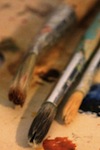 For me, pressing my brush against a canvas shakes the snow globe of monotony. It’s how I process this season of life and refill my cup. More than that, it’s the way I etch toward beauty, contemplate truth, and lasso the wayward bits of myself so I have more to give to the people I love.
For me, pressing my brush against a canvas shakes the snow globe of monotony. It’s how I process this season of life and refill my cup. More than that, it’s the way I etch toward beauty, contemplate truth, and lasso the wayward bits of myself so I have more to give to the people I love.The Gift
The young woman sitting next to me in the Denver airport gripped the grande cup of hot Earl Grey I had just purchased for her. Her name was Marta. She was seventeen, an exchange student from the Ukraine on her way back to Eugene, Oregon, for a few days of debriefing before heading home. She had spent the last year of high school with a host family in Minneapolis where I’d just attended a conference. Her wide brown eyes and long, thin legs gave her the look of a fawn — a frightened, waif-like creature. She also had a nasty cold that I did not want to catch.
 When we first started talking about an Art House Dallas launch, we knew it needed to include three aspects: good food, live music, and opportunities to gather our Dallas friends for meaningful conversations. We imagined a handful of Dallas artists and Art House America supporters would meet together for a couple of hours to talk about what it looks like to live an “artful life.”
When we first started talking about an Art House Dallas launch, we knew it needed to include three aspects: good food, live music, and opportunities to gather our Dallas friends for meaningful conversations. We imagined a handful of Dallas artists and Art House America supporters would meet together for a couple of hours to talk about what it looks like to live an “artful life.” My son Adrian, our oldest of four children, is a talented singer-songwriter and musician. I say this with as much objectivity as I can muster, for it would be easier if he wasn’t so good. I carry with me all the broken promises, misplaced optimism, wishful thinking, and bull-headed stubbornness that thirty-odd years in the music business doles out. Without a doubt, I also had some signature moments of my life, but what weighs more: the successes or the struggles?
My son Adrian, our oldest of four children, is a talented singer-songwriter and musician. I say this with as much objectivity as I can muster, for it would be easier if he wasn’t so good. I carry with me all the broken promises, misplaced optimism, wishful thinking, and bull-headed stubbornness that thirty-odd years in the music business doles out. Without a doubt, I also had some signature moments of my life, but what weighs more: the successes or the struggles?



